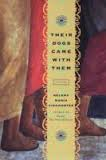In her novel Their Dogs Came With Them, Helena Viramontes chronicles the lives of four young women as they navigate their lives through the tumultuous barrio of East Los Angeles in 1960’s. Virmonte’s novel immediately takes on a feminist undercurrent as the story revolves around this group of women and the struggles of their youth. The stories are told not only from the perspective of each young woman, but are also reflected through the eyes of a multitude of other characters. We gain insight into the lives of each individual as the story delves into their past and the formative experiences of their youths and how they have come to shape them as a person in the present. The characters continue to unknowingly interrupt and intersect each other’s lives as they aimlessly search for their misplaced senses of identity. Thus far, within the first 150 pages, the encounters among this group of characters has been superficial and relatively insignificant. I am anticipating, however, that as the novel progress, the lives of these characters will be intertwined, the unforeseen consequences of their actions creating a delicate connection between them. I could not help but be reminded of the film Crash(2004) in the manner how Viramontes relies on instances of chance to bring together individuals from all spectrums of life. Similar to the novel, this notable film draws characters from the volatile urban setting of East Los Angeles, but Viramontes’s texts focuses on the Chicano population as opposed to individual’s of different races.
As I read, I could certainly identify aspects of this novel that qualify it as a noteworthy text in the study of both the Chicano and the Gothic. The fact that Viramontes draws her characters solely from the Chicano population is crucial to the understanding of the text, as the struggles of the Chicano youth growing up in East Los Angeles are extremely real. The attempts to connect with their Chicano heritage, especially for characters such as Ben and Ermila, has a profound affect on their sense of identity and adds another dimension to their psychological landscape. Perhaps one of the most obvious element of the gothic in the text is the urban landscape crafted by Viramontes. Characterized by incomplete construction, quarantine zones, curfews, and an overwhelming sense of despair this ghetto possesses an existential influence over the lives of these young woman. The religious undertones associated with the gothic also make their way into the text, namely through the character Tranquilina, the daughter of the missionaries. Finding her hope in faith, Tranquilina bears witness to an incredibly profound religious event during what resembles the combination of a baptism and exorcism of the homeless woman. Papa Tomas also resembles the Chicano trope of a curandera as he acts as the spiritual guide for the community. The overarching motif of the fate vs chance and the lack of control the characters feel over their lives was also an aspect of the novel I found significant.


I agree completely with your assessment of the text as both a Chicano work, and as a Gothic work. I believe that the main tenets in the book that express it as Gothic is the combined sense of isolation, as well as entrapment created by the fictional quarantine movement.
Because of the quarantine, the numerous main characters in the novel are constantly relegated to a place of fear. They are supposedly kept “safe” through the quarantine, but in reality lose their freedom. With cops overhead shooting at anything that moves after curfew, the characters constantly have to stay inside and listen to the whirring of choppers. This adds to the terror of the novel, which when combined with the rotting landscape around them, works to create the Gothic elements present in the novel.
In addition, I believe one can note the Chicano element in each character’s search for identity. The Chicano movement is a movement primarily grounded in the search for a concrete identity. This can be noted in each of the character’s lives, but especially Turtle’s life. Turtle is a woman pretending to be a man, who seeks an identity with the gangs that surround her. Her struggle is indicative of the Chicano movement, as she does not know what she represents, but still does her best to find it. I believe it is in these ways the text demonstrates itself as both a Chicano and Gothic text.